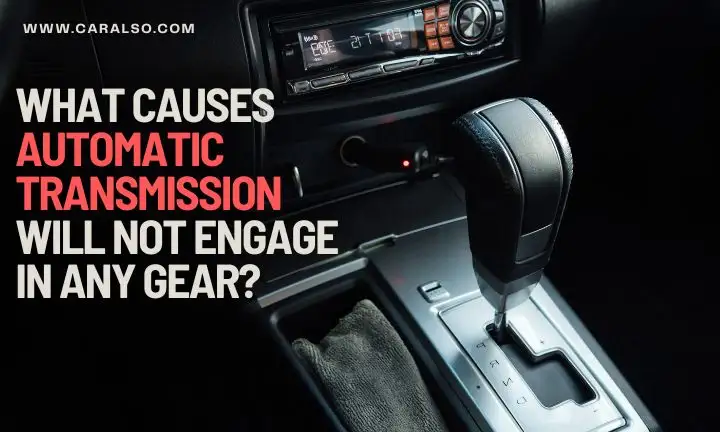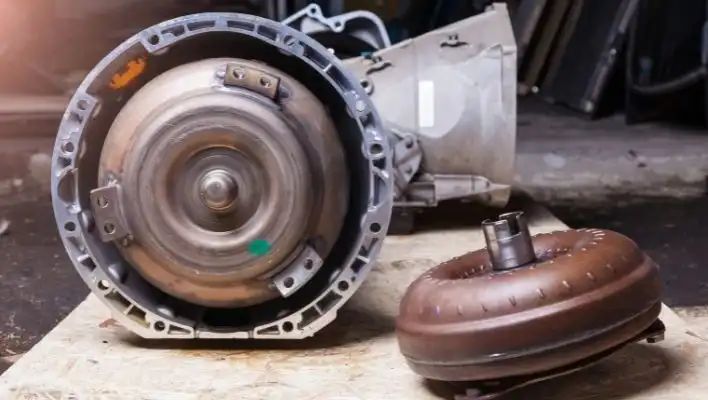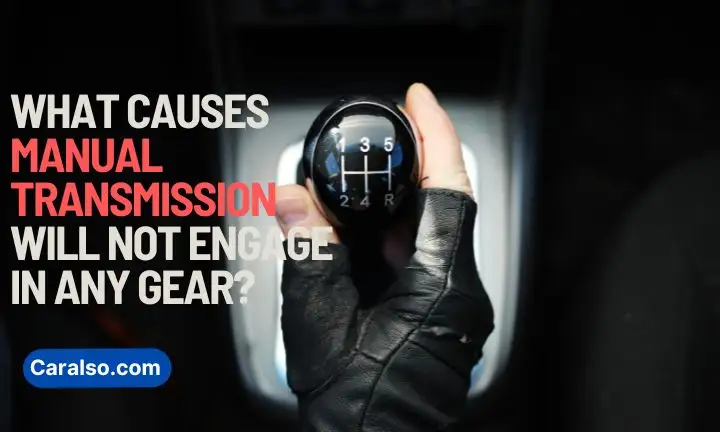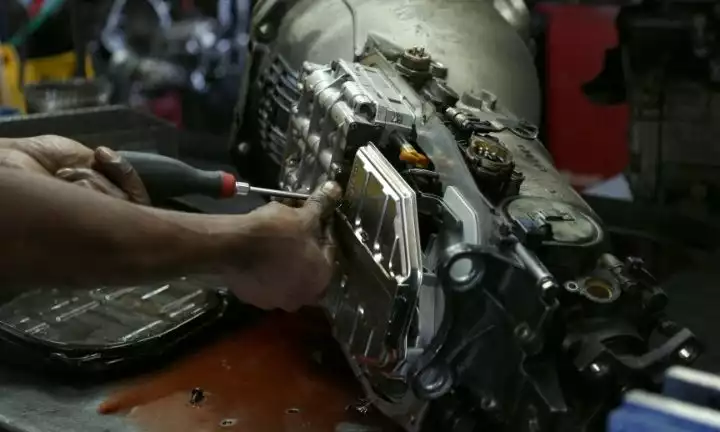The transmission will not engage in any gear when your car has damaged gears and gearbox, but there are several more common causes that you need to know.
A transmission or gearbox transfers energy from the car’s engine to the driving wheels so the driver can run the car at the desired speed. So, whether you drive an automatic or manual car, your car won’t go anywhere if the transmission does not engage in any gear.
We are going to know some most common reasons why a transmission will not engage in any gear, what you need to do when the car doesn’t go into gear, signs of transmission problems, and more here.
What Causes Automatic Transmission Will Not Engage in Any Gear?

The automatic transmission will not engage in any gear caused by a lack of transmission fluid, bad brake switch, defective torque converter, bad shift interlock solenoid, and transmission slipping.
Some causes an automatic transmission will not engage in any gear:
- Bad Shift Interlock Solenoid
- Lack of Transmission Fluid
- Defective Transmission Control Unit
- Failing Torque Converter
- Transmission Slipping
- Bad Shifter Linkage
1. Bad Shift Interlock Solenoid
You probably know about shift interlock solenoid when you drive an automatic transmission or a modern car.
The shift interlock solenoid is a safety feature that comes with modern cars that keeps the driver away from accidentally shifting out of the park when the brake pedal is not pressed down.
For any reason, if the shift interlock solenoid cannot extend or retract, this safety mechanism doesn’t work as circumstances the car does not shift out of the park, so the car won’t go anywhere.
Hence, an automatic transmission will not engage in any gear for the bad shift interlock solenoid. Presently bad shift interlock solenoid is a common issue that is found in various vehicles, and fortunately, it’s easy to fix.
Related: How To Put A Car In Neutral With A Dead Battery
2. Lack of Transmission Fluid
Lack of transmission fluid is probably the most common reason to find when your automatic transmission will not engage in any gear.
Transmission fluid is a type of hydraulic fluid that keeps the car’s transmission gears and clutch away from hard shifts. When your car has the right and sufficient level of transmission fluid, the gear shifting will be smooth.
But, when low transmission fluid won’t be able to generate as much hydraulic pressure as transmission required, it leads to gear slippage.
Transmission fluid needs to change after running 80 thousand to 100 thousand miles. Both manual and automatic transmissions need to change the transmission fluid, but manual transmission fluid needs to change more frequently.
Be aware that engine oil is not the same as transmission fluid, therefore. So, check the level of transmission fluid when the car won’t go into gear.
3. Defective Transmission Control Module
When your automatic transmission is not engaging, you better be sure the car’s transmission control module is working properly.
The transmission control module (TCM), also known as the Transmission control unit (TCU), is responsible for the efficient function of the car’s transmission, just like the car’s engine control module (ECM).
A bad transmission control module provides wrong shifting signals that cause your car can experience incorrect or unintended gear shifting.
To keep the gear shifting smooth and efficient, the contribution of the transmission control module is necessary. That’s why ensure the transmission control unit is working as it should be.
Related: How To Jump Start A Dead Battery Without Another Car
4. Failing Torque Converter

The torque converter is a major component that engages and disengages the transmission from the engine in automatic transmission.
The automatic transmission torque converter consists of other components within that if any of the components goes bad, your car transmission will not engage in any gear.
Proper check-up of the torque converter can be technical; hence it’s better to leave this matter to a professional.
Note: Both manual transmission and automatic transmission get help from the torque converter to shift gears. So, test that torque converter and ensure it is working properly, whether your car is a manual or automatic transmission.
5. Transmission Slipping
Transmission slipping means when your car engine produces the power, but the power doesn’t get to the wheels. When you notice the shifting is not smooth and the gear is not staying fully in the particular gear as you drive, then you are experiencing transmission slipping.
As is evident earlier, there are several causes of transmission slipping. The automatic and manual transmissions can slip, but transmission slipping is most common in automatic cars or trucks.
6. Bad Shifter Linkage
Shifter linkage is a strong and thick cable that connects the gear selector or gear shift to the transmission. Gear shift linkage and transmission shift linkage refers to the same thing in vehicles.
As you can understand, if the shift linkage is detached or broken, the gear selector will not connect to the transmission and this situation we describe as a car won’t go into gear commonly.
I commonly see an automatic transmission that won’t engage any gear because of the faulty shifter linkage. So, if the shifter linkage is broken, then replace or if it detached, then attract again.
What Causes Manual Transmission Will Not Engage in Any Gear?

The car’s manual transmission will not engage in any gear because of a worn or bad clutch, faulty transmission synchronizers, broken clutch pressure plate and shortage of clutch fluid.
Common causes a manual transmission won’t engage in any gear:
- Bad or Worn-out Clutch
- Shortage of Clutch Fluid
- Bad Clutch Master Cylinder
- Defective Clutch Pedal Assembly
- Bad Clutch Slave Cylinder or Clutch Fork
- Faulty Transmission Synchronizers
- Clutch Pressure Plate Failure
1. Bad or Worn-out Clutch
In any vehicle, the clutch is an important part of the transmission. Both manual and automatic transmission cars have a clutch that engages and disengages the car’s engine and transmission.
Because of the bad clutch, the manual transmission won’t go in gear. That is also the same scenario for the automatic transmission, but manual transmission cars suffer more.
The clutch disk can be worn out after long use. However, the clutch is a long-lasting component that supports transmission. So, when the clutch is bad, it simply cannot engage and disengage the transmission gear.
2. Shortage of Clutch Fluid
The clutch fluid sometimes refers to brake fluid because both have the same job in the vehicle. The clutch fluid is a type of oil or hydraulic fluid that is kept in the clutch master cylinder to facilitate gear shifting.
When the manual transmission does not engage in any gear, you should check the level of clutch fluid because the shortage of clutch fluid will definitely become an obstacle to smooth gear shifting.
In many cases, I found that for the leakage in the clutch master cylinder, a shortage of clutch fluid situation occurs. Typically, car owners should refill the clutch fluid every one and a half years to two years consecutively.
Fortunately, it’s easy to know the level of clutch fluid by looking at the clutch reservoir in a car’s engine bay.
3. Bad Clutch Master Cylinder
Manual transmission relay on the clutch master cylinder or clutch pump. The clutch master cylinder facilitates the mechanical movement of the clutch pedal to hydraulic pressure.
So, if your car has a failing clutch master cylinder, this will not be able to produce enough hydraulic pressure to engage or disengage the clutch.
Be aware of any leakages; the lack of brake fluid will keep your car’s clutch master cylinder safe and good.
4. Defective Clutch Pedal Assembly
Nowadays, car manufacturers are taking extra care to make the clutch pedal assembly long-lasting and operative. The clutch pedal assembly is also known as the brake pedal assembly.
A bad or defective clutch pedal assembly will not be able to operate the clutch and eventually make the transmission not engaging.
5. Bad Clutch Slave Cylinder or Clutch Fork
The driver of a manual transmission car will not be able to switch gears if the clutch slave cylinder is bad because a clutch slave cylinder is an integral part of the manual transmission.
With that being said, the clutch slave cylinder also needs a supporting part that is called a clutch fork. Hence, the manual transmission will not engage in any gear if the clutch slave cylinder and clutch fork are bad.
6. Faulty Transmission Synchronizers
The manual transmission synchronizer is responsible for the smooth engagement of gears. The synchronizer is only used in manual transmission.
Sometimes the manual transmission synchronizer also refers to the gear synchronizer. When the transmission synchronizer fails, the manual car’s gear won’t adjust shifting with speed, which damages the transmission and puts you in danger.
The easy way to determine a bad manual transmission synchronizer is to hear whirring or humming noises while you shift in a specific gear.
7. Clutch Pressure Plate Failure
A manual transmission will not engage in any gear if the clutch pressure plate is broken because the clutch pressure plate also assists the power to flow from the engine to the transmission.
The clutch pressure plate consists of a number of covers and releases fingers; therefore, if any of the fingers are broken, the clutch pressure plate will not be able to disengage properly.
An unconstrained or very loose clutch pedal feels like it is a sign of a bad or broken clutch pressure plate.
What To Do When Your Car Doesn’t Go Into Gear?

When the clutch is working properly, most gear-shifting problems go away. But, there are several solutions that you will need to consider if the car won’t go into gear.
Things you can do when the car doesn’t go into gear:
Make Sure the Clutch is Working Optimally
When you are driving a manual transmission car, and the car won’t go into gear, then it’s most probably because the clutch is not working as it should be.
A clutch might not work optimally because of pressure plate failure, broken clutch fork, wrong clutch pedal assembly, damaged throwout bearing and more.
Mentioned any causes your car’s clutch can go bad instantly, and as you know, a faulty clutch is the most common reason why a manual transmission does not engage any gear.
So, if the car or truck won’t go into gear, check the clutch first, and make sure the clutch operates perfectly with gear shifting.
Fill Up Transmission Fluid
Topping off the transmission fluid can be a simple and easy solution when your car won’t go into gear because low transmission fluid prevents lubricating the transmission, so gear shifting becomes hard.
Now, the transmission fluid can be dirty, goopy or even burned, but a car needs fresh fluid in the transmission valve body.
So, along with checking the level, you also need to ensure the transmission is not dirty if it then replaces the transmission fluid with new.
Press the Clutch Pedal Down More
If you are looking for an instant solution for the car that won’t go into gear then, pressing the clutch pedal down a little bit more before changing gears.
When the clutch pedal is all the way to the floor, you need to try changing the gears again.
This is also a common practice that most auto mechanics test when the manual transmission does not engage in any gear.
Check Shifter Linkage
As I described in the previous section of the article, what does the shifter linkage do. Therefore, checking the shifter linkage to ensure the cable is connected properly and not broken is another way to fix the car’s transmission engaging problems.
Since not every car owner doesn’t have enough knowledge about the car’s transmission, that’s why I recommend you check the shifter linkage with a mechanic.
Replace the Faulty Transmission Control Unit (TCU)
Automatic cars use the transmission control unit (TCU) electric device to run efficiently, and the TCU is also connected to the car computer, known as ECM. But, a manual transmission car does not have a TCU.
Worn-out wiring or wrong cable connection between the transmission control module (TCM) and the car’s other electric devices can make the transmission control unit bad.
Try To Put Your Car Into a Different Gear
Another quick and useful thing to do when the transmission is not engaging is to try to put the car into a different gear fast.
You can easily determine which gear is not shifting by trying to put your car into a different gear.
Why Automatic Transmission Goes Into Gear But Won’t Move?
The most common cause of an automatic transmission going into gear but won’t move because of a bad valve body. For a failing valve body, automatic transmission can delay shifting.
The valve body is the vital part of an automatic transmission that is responsible for giving signals to engage the clutch and shift at the right time.
Therefore, it’s hard for an automatic transmission when it’s not getting signals for shifting because of a faulty valve body.
Of course, there can be other causes why an automatic transmission goes into gear, but the car is not moving. However, you should taste the valve body first, then others.
Repairing Cost of A Transmission That Will Not Engage in Any Gear
You can expect a minimum of $120 to a maximum of $900 repairing cost of a transmission that does not engage in any gear. Also, repairing costs can vary from your state’s tax too.
As you can see, for various reasons, the transmission will not engage in any gear; that’s why you can tell the repair cost is also going to vary.
Typically, repairing any components of transmission is expensive. Suppose, as I mentioned, a defective clutch plate and the clutch system can make the transmission not engage, so if you need to repair the clutch plate, it will cost you over seven hundred bucks.
So, you can expect to pay the mechanic a little more when it comes to transmission problems in your car.
Final Words
The causes of transmission will not engage in any gear going to be different for automatic and manual transmission because both transmissions operate in different manners. But, some reasons can be common in both transmissions.
In most cases, bad shifter linkage, defective transmission control unit (TCU), and failing torque converter are the common causes of why an automatic transmission will not engage in any gear.
On the other hand, a manual transmission will not engage in any gear because of a bad clutch pressure plate, slave cylinder, and master cylinder. So, you can see if the clutch is not operating optimally, the manual transmission is not going into gear.
However, a lack of transmission fluid can prevent both automatic and manual transmission from engaging in gear.
Related Solutions:
Ways To Disable A Car From Starting
Things To Put In A Gas Tank To Ruin A Car Engine

Hey there,
How is it going?
I’m Meraj Sarker. I am a Car Mechanic and a student of Automobile Restoration here in Florida, USA. I’ve been studying automotive for around 9 years now. So you can rely on my recommendation. For me, studying and getting knowledge about automobile it’s really fun and entertaining. I will help you to get solutions for your car through this website. If you need any help let me know.

